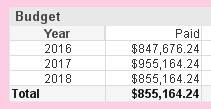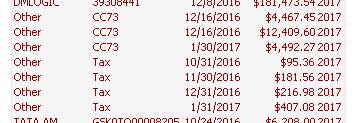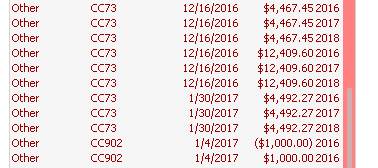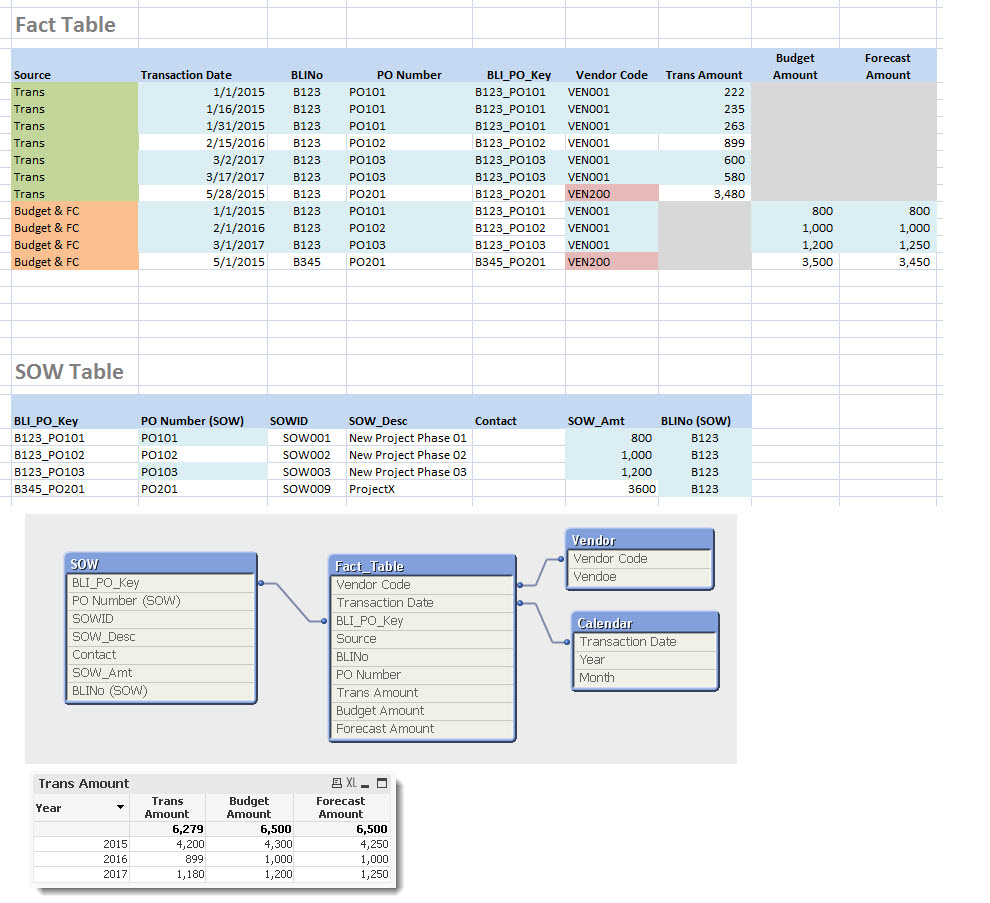Unlock a world of possibilities! Login now and discover the exclusive benefits awaiting you.
- Qlik Community
- :
- All Forums
- :
- QlikView App Dev
- :
- Re: Simple Chart - Forecast and Actual Paid does n...
- Subscribe to RSS Feed
- Mark Topic as New
- Mark Topic as Read
- Float this Topic for Current User
- Bookmark
- Subscribe
- Mute
- Printer Friendly Page
- Mark as New
- Bookmark
- Subscribe
- Mute
- Subscribe to RSS Feed
- Permalink
- Report Inappropriate Content
Simple Chart - Forecast and Actual Paid does not work
Your help would be very much appreciated. I have, what I think is, a simple setup with Budget line items (BLI), Statements of work (SOW, aka Purchase Order) and Transactions (Trxn, aka Paid). The Bugdet includes, for each BLI, a monthly budget and forecast. All the input is XLS.

When I create a QV table of sums by year, the yearly sum are not correct – the total is correct.
If I add a column to my Trxn table, TrxnYear, I can get the table above to work BUT if I add sum(TrxnAmount) to any other table, it has the same error.
Below is my data structure, the budget XLS and excerpts from a table box that lists the transactions. I have included my MasterCalendar script also. Below the structure are excerpts from a table box that lists the transactions demonstrate the issue…see Year in the last column (this is before I added TrxnYear).

Budget table (XLS)

When I ask to see Just 2016

When I ask to see just 2017

When I ask for ALL years (these dups don’t appear when I remove the Year column)

These dups don’t appear when I remove the Year column.

- « Previous Replies
-
- 1
- 2
- Next Replies »
Accepted Solutions
- Mark as New
- Bookmark
- Subscribe
- Mute
- Subscribe to RSS Feed
- Permalink
- Report Inappropriate Content
Hi Karen
Try to get all the Facts in one fact table. The granularity could be different from for Actual transactions, budget & forecast. Having one fact table makes everything easier on the front end.
Hope this help you.
Nav Pienaar

- Mark as New
- Bookmark
- Subscribe
- Mute
- Subscribe to RSS Feed
- Permalink
- Report Inappropriate Content
Are you filtering on the correct year?
TrxnYear from Trxn table should be filtered on not Year from Master calendar .
I think your budget table has same blin numbers for multiple dates across both years
Create a composite key with a combination of blin and date to connect budget and Sow tables
If a post helps to resolve your issue, please accept it as a Solution.
- Mark as New
- Bookmark
- Subscribe
- Mute
- Subscribe to RSS Feed
- Permalink
- Report Inappropriate Content
I am using TrxnYear, I think. I'll have to see. how can I use a different year in the same table - as in BudgetYear for the Budget sum and TrxnYear for the Trxn sum?
- Mark as New
- Bookmark
- Subscribe
- Mute
- Subscribe to RSS Feed
- Permalink
- Report Inappropriate Content
Are my answers in Canonical Calendar and/or HERE?
If so...having difficulty implementing a Canonical Calendar.
- Mark as New
- Bookmark
- Subscribe
- Mute
- Subscribe to RSS Feed
- Permalink
- Report Inappropriate Content
Forgot to include my Master Calendar Script
MinMax:
LOAD
Min(BudgetDate) as MinDate,
Max(BudgetDate) as MaxDate
RESIDENT Budget;
LET vMinDate = Num(Peek('MinDate', 0,'MinMax'));
LET vMaxDate = Num(Peek('MaxDate', 0,'MinMax'));
LET vToday = $(vMaxDate);
//*********Temporary Calendar*********
TempCal:
LOAD
date($(vMinDate) + rowno() - 1) As TempDate
AUTOGENERATE
$(vMaxDate) - $(vMinDate) + 1;
DROP TABLE MinMax;
//*********Master Calendar*********
MasterCalendar:
LOAD
TempDate As BudgetDate,
Week(TempDate) as Week,
Year(TempDate) as Year,
Month(TempDate) as Month,
Day(TempDate) as Day,
WeekDay(TempDate) as WeekDay,
'Q' & ceil(month(TempDate) / 3) as Quarter,
Date(monthstart(TempDate), 'MMM-YYYY') as MonthYear,
Week(TempDate)&'-'&Year(TempDate) as WeekYear,
inyeartodate(TempDate, $(vToday), 0) * -1 as CurYTDFlag,
inyeartodate(TempDate, $(vToday), -1) * -1 as LastYTDFlag
RESIDENT TempCal
ORDER BY TempDate ASC;
DROP TABLE TempCal;
- Mark as New
- Bookmark
- Subscribe
- Mute
- Subscribe to RSS Feed
- Permalink
- Report Inappropriate Content
Instead of connecting trxn to >> Sow to >> Budget
Change it to Sow >> Trxn >> to Budget
Applymap Blino to Trxn table using purchaseorderid , drop the field Blino from Sow and let it connect to Trxn only with purchaseorderid
In trxn table Create a key with Blino & TranDate as Key
In Budget table create a key with Blino & Budget Date as Key
Rename the Blino field in both tables, Trxn and Budget table to avoid a synthetic key
If a post helps to resolve your issue, please accept it as a Solution.
- Mark as New
- Bookmark
- Subscribe
- Mute
- Subscribe to RSS Feed
- Permalink
- Report Inappropriate Content
Even better would be to create a link table with a master calendar
Sow >> Trxn >> Link table with keys from both tables + Calendar fields >> Budget table
If a post helps to resolve your issue, please accept it as a Solution.
- Mark as New
- Bookmark
- Subscribe
- Mute
- Subscribe to RSS Feed
- Permalink
- Report Inappropriate Content
I am going to try BLINo+Date to add an key to the forecast and remove Forecast to a separate table with no date. I don't want to add BLINo to the Trxn, as that would be only semi-automated. The automated extract includes SOW, but no reference to the BLI.
BLI have monthly budget amount and monthly forecast amounts

BLIs can have multiple SOWs. SOWs can have multiple transactions - sometimes more than one a month.
- Mark as New
- Bookmark
- Subscribe
- Mute
- Subscribe to RSS Feed
- Permalink
- Report Inappropriate Content
I've worked thru a few options - learning now the mapping and link table work. So now I think I understand what you are suggesting. I will try that tomorrow. And let you know!
- Mark as New
- Bookmark
- Subscribe
- Mute
- Subscribe to RSS Feed
- Permalink
- Report Inappropriate Content
Hi Karen
Try to get all the Facts in one fact table. The granularity could be different from for Actual transactions, budget & forecast. Having one fact table makes everything easier on the front end.
Hope this help you.
Nav Pienaar

- « Previous Replies
-
- 1
- 2
- Next Replies »